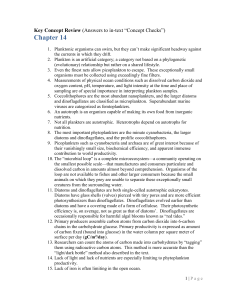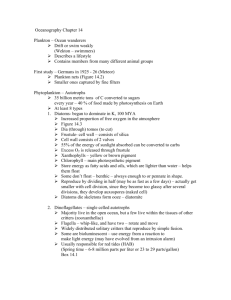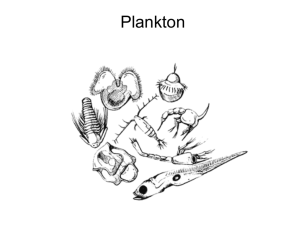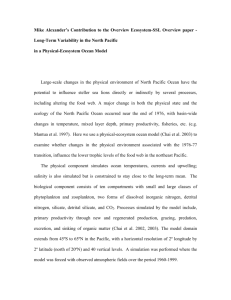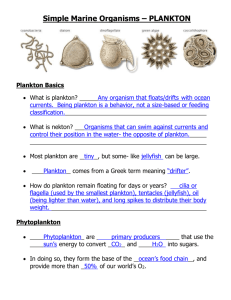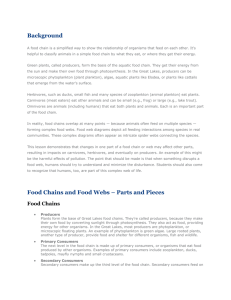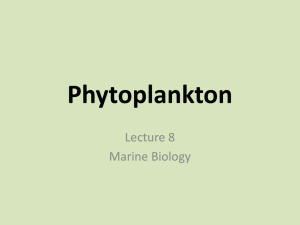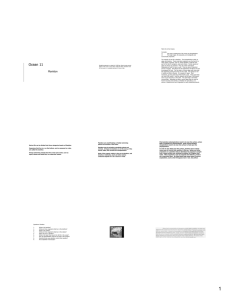Ch. 14: Plankton, Algae, & Plants Lecture Notes Page
advertisement
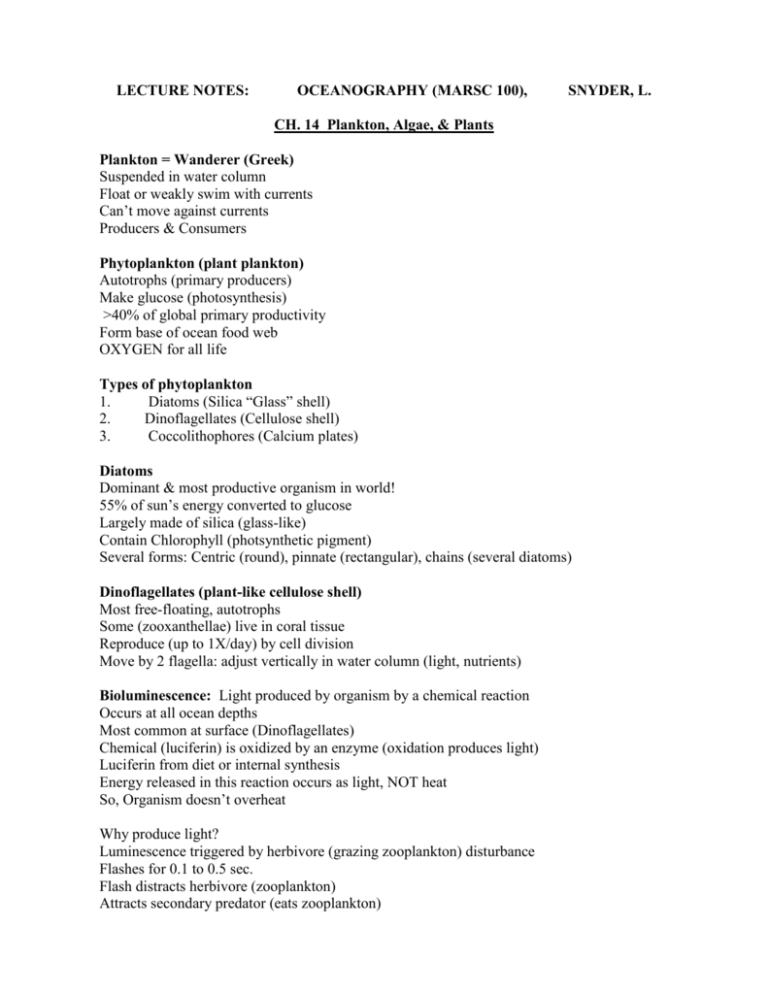
LECTURE NOTES: OCEANOGRAPHY (MARSC 100), SNYDER, L. CH. 14 Plankton, Algae, & Plants Plankton = Wanderer (Greek) Suspended in water column Float or weakly swim with currents Can’t move against currents Producers & Consumers Phytoplankton (plant plankton) Autotrophs (primary producers) Make glucose (photosynthesis) >40% of global primary productivity Form base of ocean food web OXYGEN for all life Types of phytoplankton 1. Diatoms (Silica “Glass” shell) 2. Dinoflagellates (Cellulose shell) 3. Coccolithophores (Calcium plates) Diatoms Dominant & most productive organism in world! 55% of sun’s energy converted to glucose Largely made of silica (glass-like) Contain Chlorophyll (photsynthetic pigment) Several forms: Centric (round), pinnate (rectangular), chains (several diatoms) Dinoflagellates (plant-like cellulose shell) Most free-floating, autotrophs Some (zooxanthellae) live in coral tissue Reproduce (up to 1X/day) by cell division Move by 2 flagella: adjust vertically in water column (light, nutrients) Bioluminescence: Light produced by organism by a chemical reaction Occurs at all ocean depths Most common at surface (Dinoflagellates) Chemical (luciferin) is oxidized by an enzyme (oxidation produces light) Luciferin from diet or internal synthesis Energy released in this reaction occurs as light, NOT heat So, Organism doesn’t overheat Why produce light? Luminescence triggered by herbivore (grazing zooplankton) disturbance Flashes for 0.1 to 0.5 sec. Flash distracts herbivore (zooplankton) Attracts secondary predator (eats zooplankton) Dinoflagellate – less likely to be eaten Red Tide (Dinoflagellate Bloom) Phylum Pyrrophyta = “Fire Plant” Mass development of dinoflagellates discolor water Often caused by excess nutrients that Enter ocean from land (runoff) : Fertilizer, sewage Red tide impacts: Fish kills Toxic to marine life: accumulates in clams, mussels, scallops, fish, mammals Death to some species, Human poisoning after consumption (30 min.) Symptoms: Paralytic: paralysis, asthma, heart attack (rare) Neurotoxic: tingling, paralysis, memory loss Diarrhetic: cramps, vomiting, diarrhea Phytoplankton Productivity Limited By: Light Availability – Photosynthesis ↓ with depth, season, latitude Little photosynthesis below 100m (330ft) Nutrient Availability – “Natural fertilizer” Upwelling - aids primary production by bringing nutrients to surface Zooplankton (poop, death) – leads to future phytoplankton blooms Water temperature: diatoms like cool H2O Zooplankton (Animal Plankton) Heterotrophic = Consumers Mostly eat phytoplankton, or other zooplankton Most can move Spend whole life as plankton OR Larval stage only Holoplanton: Plankton for whole life Small, single-celled, many with shell Small, but NUMEROUS! Foraminifera, Ciliates Copepods = 70% of all Zooplankton (Most numerous animal on Earth!) Big (Macroplankton), but still floaters Krill: ~5 cm (2”), Herbivores : Numerous in Antarctica (Eaten by Whales, birds, seals, fish, squid) Cnidarians (jellies): body parts specialized (feeding arms, stinging arms have cells with nematocysts that sting prey) Meroplankton (Temporary plankton) Early life as plankton (float): Larvae, eggs Rest of life: benthic, pelagic swimmers, intertidal EX: Fish, crabs, lobster, sea urchin, squid, clam, etc. Larger, Attached Marine Producers: 1. Plants: Surface dwelling Angiosperms: Reproduce with flowers & seeds Only grow in photic zone a. Sea “grasses” Pollen distributed by H2O Roots help uptake nutrients High productivity Surfgrass: Wave swept subtidal Eelgrass: Shallow water of Estuaries & bays 2. b. Mangroves: Salt-tolerant trees Found in Tropical estuaries c. Salt Marsh Halophytes: salt tolerant Grasses & succulents Found in Temperate estuaries Ex. Cordgrass, Battis, Pickleweed Algae (seaweed): 3 groups Only grow in photic zone Flexible, covered in gelatinous material Highly productive: Water, CO2, & nutrients readily available a. Green Algae (Chlorophyta) Photosynthesis: Use chlorophyll, No accessory pigments Live at or near surface, To depths: 10 m (33ft) Ex: Sea lettuce (Ulva sp.), Dead Man’s Fingers (Codium fragile) b. Red Algae (Rhodophyta) Surface & deeper water to 268m (879 ft) Have Accessory pigments that aid photosynthesis EX: Coralline algae – Has Calcium carbonate in tissues that protects from grazing herbivores & wave action c. Brown Algae (Phaeophyta) Include Kelps (to 200 ft long) Held to substrate with holdfast (root-like structure, but does not take up nutrients or water) Grow in H2O to 115 ft deep Have Accessory pigments Quick growth (20”/day) EX: Macrocystis (Giant Kelp), Feather Boa Kelp Kelp Forests: Temperate & polar latitudes (30° N & S to poles) Replaced by mangroves in tropical latitudes)

